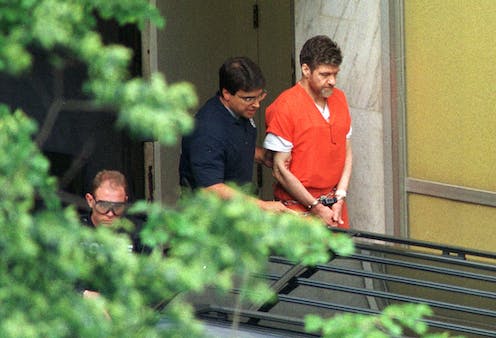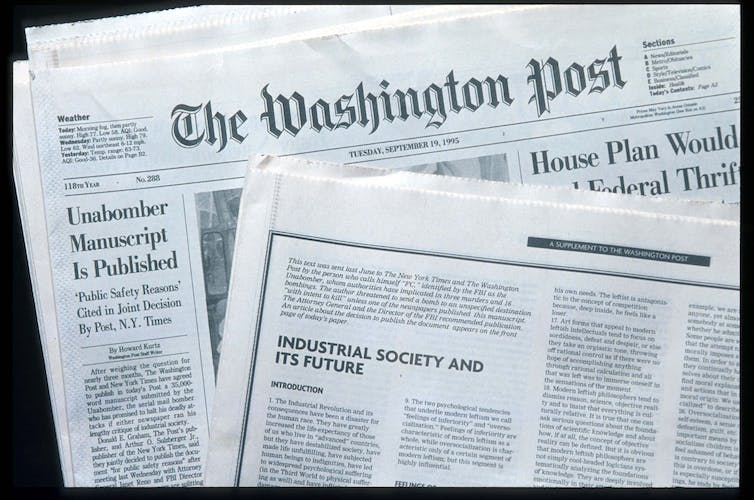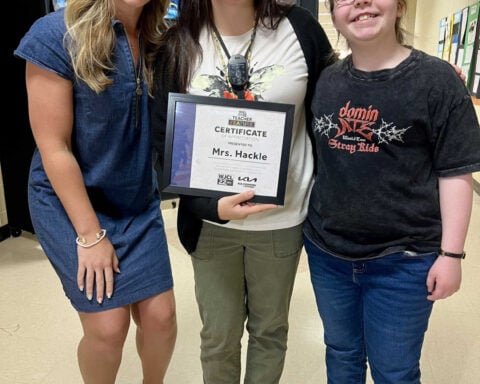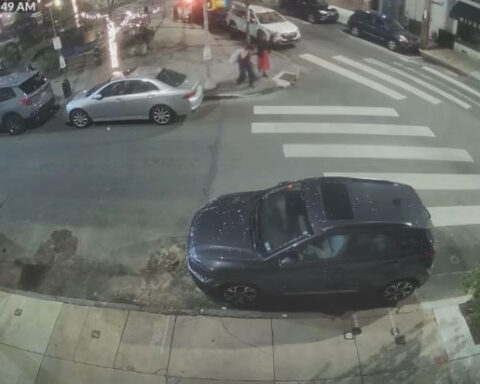
Ted Kaczynski was arrested after the longest and most expensive investigation in the FBI's history.
Can the language someone uses be as unique as their fingerprints?

As I describe in my forthcoming book, “Linguistic Fingerprints: How Language Creates and Reveals Identity,” that was true in the case of Theodore Kaczynski.
Kaczynski, who was known as the Unabomber, died in a North Carolina prison on June 10, 2023, reportedly by suicide.
Kaczynski had been a math prodigy and a professor at the University of California, Berkeley, before he withdrew from society and declared war on the modern world.
From a remote cabin in Montana, he sent a number of explosive devices through the mail. In other cases, he planted them. Between 1978 and 1995, 16 of his bombs killed three people and seriously injured nearly two dozen more.

Kaczynski’s crimes triggered the longest and most expensive criminal investigation in U.S. history. Law enforcement had little to go on other than a few letters that the terrorist had sent to the media, as well as fragments of notes that had survived his device’s detonations.
Spellings and word choices offer clues
In 1995, there was a breakthrough. That’s when the Unabomber offered to pause his attacks if a newspaper published his manifesto about the evils of modern society. Controversially, The Washington Post did so. The FBI supported the paper’s decision, hoping that someone would recognize the terrorist based on the writing style of the 35,000-word essay.

The Washington Post published the Unabomber’s 35,000-word manifesto on Sept. 19, 1995.

FBI forensic linguist James Fitzgerald and sociolinguist Roger Shuy were able to uncover several clues about the terrorist’s identity based on the manifesto and his other writings.
For example, the Unabomber used strange misspellings for some words, such as “wilfully” for “willfully,” and “clew” for “clue.” Shuy recognized these as spelling reforms that had been championed by The Chicago Tribune during the 1940s and 1950s, although they were never widely adopted.
Their use by the bomber suggested he might have spent his formative years in or near Chicago.
Fitzgerald noted the use of terms like “broad,” “chick” and “negro” in the manifesto was consistent with the vocabulary a middle-aged person from that era.

The Unabomber also referred to “rearing children” as opposed to “raising children.” The former term is characteristic of the northern U.S. dialect and would be consistent with someone who grew up in or near the Windy City.
The manifesto also contains such fairly esoteric terms as “anomic” and “chimerical,” suggesting that its author was highly educated.
A brother’s suspicions
But the move to publish the manifesto ended up being the decisive factor.
It was read in Schenectady, New York, by Linda Patrik, who showed it to her husband, David Kaczynski. She asked if he thought it sounded like something his brother Ted could have written.

David was initially skeptical. Then he noticed that the essay contained unusual expressions, like “cool-headed logicians,” that he remembered his estranged sibling making use of. He approached the FBI with his suspicions, and it was noted that David’s brother had been born in Chicago in 1942.
A search of Kaczynski’s cabin turned up explosive devices, as well as the original copy of the manifesto. Kaczynski pleaded guilty in 1998 and was incarcerated until his death at age 81.
Fingerprinting authors
The Unabomber investigation has been justifiably hailed as a triumph of forensic linguistics. But sleuths of prose and punctuation have had other notable victories.
Even something as seemingly trivial as unusual punctuation can provide clues to a suspect’s identity – which is what happened in 2018, when a forensic linguist was able to pin a murder on a British man because of his unusual use of commas and spacing when sending text messages.

Similar techniques have been used by language experts to identify authors. In 1996, “Primary Colors,” a novel based on Bill Clinton’s presidential campaign, was published by “anonymous.” English professor Donald Foster was able to finger Newsweek columnist Joe Klein as the author of the work, noting similarities between the text of “Primary Colors” and Klein’s other published work, which included the use of unusual adverbs (“goofily”), states described as modes (“crisis mode”) and drawn-out interjections (“naww”).
And in 2013, “The Cuckoo’s Calling,” a novel authored with the pen name Robert Galbraith, was exposed as having been written by J.K. Rowling. Patrick Juola, a computer scientist, and Peter Millican, a philosopher, independently identified the author of the Harry Potter series as the crime novel’s true author. Both men used computer programs to analyze such factors as the distribution of word lengths and common word usage in books written by several suspected authors. They then compared the results to “The Cuckoo’s Calling” and identified Rowling as the closest match.
An infallible method?
These techniques seem almost magical when they work. But they’re not foolproof.
In 2018, The New York Times published an op-ed written by an anonymous “resister” inside the Trump administration. However, the editorial was too short for linguistic analysis.

Even after the resister published a full-length book, titled “A Warning,” it wasn’t possible to identify the author. He eventually outed himself as Miles Taylor. He had served as the chief of staff in the Department of Homeland Security. But because he had never published anything else, there was no text to which “A Warning” could be compared.

The public learned of Miles Taylor’s identity only after he revealed himself as the author of ‘A Warning.’
And scholars are still debating the identity of Elena Ferrante, the pseudonym used by a bestselling Italian novelist. Ferrante has published a dozen books, including “My Brilliant Friend,” but the author’s true identity remains controversial.

Either way, technological advances have made it increasingly difficult for people who leave a paper trail to hide their identities – and the old adage to “not put anything in writing” is as true as it’s ever been.
Roger J. Kreuz does not work for, consult, own shares in or receive funding from any company or organization that would benefit from this article, and has disclosed no relevant affiliations beyond their academic appointment.

 Trump has begun another trade war. Here's a timeline of how we got here
Trump has begun another trade war. Here's a timeline of how we got here
 Canada's leader laments lost friendship with US in town that sheltered stranded Americans after 9/11
Canada's leader laments lost friendship with US in town that sheltered stranded Americans after 9/11
 Chinese EV giant BYD's fourth-quarter profit leaps 73%
Chinese EV giant BYD's fourth-quarter profit leaps 73%
 You're an American in another land? Prepare to talk about the why and how of Trump 2.0
You're an American in another land? Prepare to talk about the why and how of Trump 2.0
 Chalk talk: Star power, top teams and No. 5 seeds headline the women's March Madness Sweet 16
Chalk talk: Star power, top teams and No. 5 seeds headline the women's March Madness Sweet 16
 Purdue returns to Sweet 16 with 76-62 win over McNeese in March Madness
Purdue returns to Sweet 16 with 76-62 win over McNeese in March Madness







